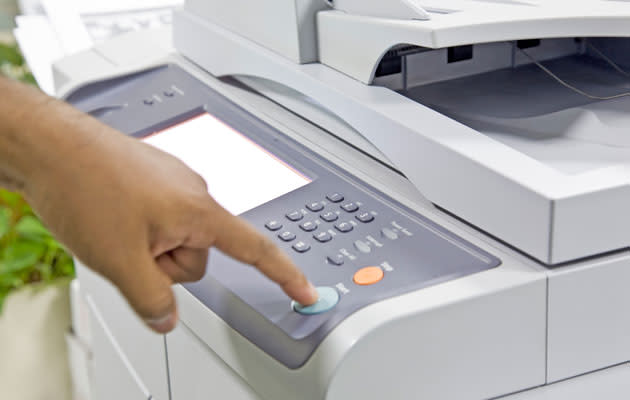 Fit to Post Health
Fit to Post HealthYour office photocopier may not be as harmless as you think
Photocopiers are oh-so-essential in the modern office. But as we focus on the machines' sleek design, high-performance functionality and good quality printing, we neglect to consider how potentially risky they can be — to our health.
"Workers are using these office machines every single day. Yet not many realise that, under certain circumstances, they can bring on health problems, especially in those with pre-existing respiratory conditions" observes Dr Chew Huck Chin, Associate Consultant, Department of Respiratory and Critical Care, Singapore General Hospital (SGH).
Photocopiers create ozone gas
Ozone, a form of oxygen, is a normal constituent of the earth's atmosphere. It's a highly reactive, unstable, colourless gas with a distinctive odour.
"Photocopiers create ozone through their "corona wires" that apply a charge to the paper so the ink will cling to it," explains Chew. "As ozone is highly reactive, any adverse health effects will be found essentially at the sites of initial contact — the respiratory tract (nose, throat and airways), the lungs and at higher concentrations, the eyes."
If exposed to ozone, one could experience headaches, eye and breathing irritations. Chew adds: "It is worse for those with underlying respiratory conditions like asthma, as they are more sensitive to such irritants."
Related video: Do traditional Chinese remedies for asthma actually work?
Toner dust can cause respiratory tract irritation too
Photocopiers use toner, an extremely fine powder, as part of the printing process.
In substantial quantities, toner may cause respiratory tract irritation resulting in coughing and sneezing. It can also be an irritant to those with respiratory conditions such as asthma or bronchitis.
There are a few situations where one could be accidentally exposed to toner dust. "Toner dust spilled inside the machine could become airborne after passing through the ventilation fans into the room," says Chew. "Or, there could be a spillage when one is replacing the toner cartridge."
Other health hazards
Besides ozone gas and toner dust, there are other health hazards associated with photocopiers.
Selenium: Selenium is a photoconductive coating applied to the photocopying drum. "If the photocopier overheats during operation, it may cause this coating to degenerate," explains Chew. "Exposure to selenium is generally accompanied by a metallic taste in the mouth, and a garlic-smelling breath. Long periods of exposure can cause fatigue, insomnia, poor concentration, as well as upper respiratory tract disorders, and irritation of the eyes and lips." The good news is that selenium exposure is rare, and can be successfully treated.
Carbon monoxide gas: When a photocopier is placed in a poorly ventilated environment, it can emit carbon monoxide, a deadly, colourless, odourless and poisonous gas. Chew says: "Initial symptoms of carbon monoxide poisoning can include headaches, fatigue, shortness of breath, nausea and dizziness."
Bright light: After hours of direct exposure, the intense light used in photocopying may cause eye irritation and after-imaging. Chew adds: "The photocopier cover should be closed before copying. Alternatively, operators should avert their eyes from the light source."
Related article: Can air pollutants be stored in the body?
Ways to safeguard your health
Chew lists the ways you can safeguard your health, especially if you have a say in the buying and maintenance of office equipment.
Choose low-emission photocopiers: Choose dry-process photocopiers, not wet-process ones. Also, choose photocopiers that do not run as hot so that they will not produce as much ozone. Some newer models use a different system to reduce the amount of ozone produced by the machine. The average ozone emitted is 40 µg/copy. At peak production, it is 131 µg/copy.
An ozone filter is a must: Ensure that the photocopier is equipped with an ozone filter which rapidly decomposes the ozone gas in the machine's exhaust to convert it to ordinary oxygen. These filters should be replaced after a certain number of pages have been printed (approximately 50,000 sheets).
Keep your distance: The photocopier should be placed such that exhaust emissions do not travel over workstations or personnel. The more often a photocopier is used or the more duplicating machines there are, the more important it is that they are placed in a separate room with local (and separate) mechanical exhaust ventilation.
Ventilate the room: Make sure that the room in which the photocopier is placed is well-ventilated, whether it is by natural or mechanical means. If not, the levels of ozone could build up to dangerous levels. It would be even better if the photocopier is placed in a dedicated room of its own.
Maintain it well: Have photocopiers maintained on a regular basis. For example, ozone emission from five copiers that the US Environmental Protection Agency (EPA) tested dropped from a range of 16 µg/copy to131 µg/copy before maintenance to 1 µg/copy to 4 µg/copy after maintenance.
Manage refills and spillages well: Refilling techniques for the toner in dry (also known as xerographic) machines should be given special attention, avoiding spillage as far as possible. But if spillages happen, they should be cleaned up with care. Vacuum up the spillage instead of brushing it off. Then, wipe off the remainder dust using a damp cloth. Ideally, those with compromised respiratory systems should not be asked to do this.
This article was written by Jaclyn Lim for Health Xchange, with expert input from the Department of Respiratory and Critical Care, Singapore General Hospital.
Want to win a free cutlery set? "Pain Management" is one of the topics featured on Health Xchange's "Ask the Specialist" Q&A session this month (May 2012). The first 20 people to post a valid question will receive a free cutlery set! Visit HealthXchange.com.sg, Singapore's trusted health and lifestyle portal.
Find more health-related tips and articles on HealthXchange.com.sg, Singapore's trusted health and lifestyle portal.
Health Xchange's articles are meant for informational purposes only and cannot replace professional surgical, medical or health advice, examination, diagnosis, or treatment.


